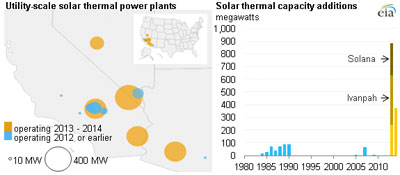Solar – which was just a gleam in the eye of researchers and entrepreneurs a decade ago – accounted for fully 73% of all new US electrical capacity that came online in October, reports the Federal Electric Regulatory Commission (FERC).
504 of the 699 megawatts (MW) of power that connected to the grid last month came from just 12 utility-scale solar projects that came online, says FERC’s "Energy Infrastructure Update."
The latest big solar project to begin commercial operation is the 139 MW Campo Verde Solar Facility in Imperial County, California, which started sending energy to the grid October 25. It’s nowhere near as big as other recent entrants, but the thin-film solar plant is still impressive, supplying energy to 48,000 homes.
First Solar built the 2.3 million-module plant, which is the fifth joint venture between Southern Power and Ted Turner’s renewable energy company. San Diego Gas & Electric is purchasing all the energy under a 20-year agreement.
Over the last month, several enormous solar projects have started producing energy:
- Ivanpah Solar Electric Generating System: 377 MW concentrating solar plant – the biggest in the world – in California, owned by utility NRG and Google.
- Solana Generating Station: 280 MW concentrating solar plant in Arizona, owned by Abengoa – the first to store energy
- California Valley Solar Ranch: 250 MW solar PV plant in California, owned by NRG

Other projects are smaller and are spread across the US, such as a 10 MW solar system at Indianapolis International Airport – the biggest for an airport – to a 3.8 MW project in Massachusetts.
All told, the US now has 4.7 gigawatts (GW) of utility-scale solar with another 30 projects totaling 27 GW under construction. About 13 GW will be online by year-end, serving 2 million homes, increasing to 5 million homes over the next few years.
FERC Further Assists Solar
This month, FERC updated a rule to further expedite solar by making it easier and less expensive for small generators to connect to the grid.
In 2005, FERC issued a rule that directs utilities to fast-track projects smaller than 2 MW onto the grid. Because of the growing volume of solar projects, FERC now modified the rule so that fast-tracking applies to projects up to 5 MW.
That means small projects can get quickly connected without any expensive studies about how it will affect grid reliability. Aspects other than size will be taken into account that are just as important for grid considerations, such as how close the solar project is to a substation and the voltage and wire thickness of nearby transmission lines.
Another change responds to the growing volume of interconnection applications and number of circuits that are starting to see high penetration rates of renewables. If a solar generator fails some of the Fast Track requirements, it can ask for a supplemental review rather than having to produce a full blown study.
Finally, to cut the volume of interconnection requests, solar developers will be able to access information about local grid conditions before filing a request.
"FERC’s rule changes are an important step forward for interconnection in the United States," says Jane Weissman, CEO of the Interstate Renewable Energy Council (IREC), which made the recommendations after surveying stakeholders. "The changes will enable utilities to more effectively process applications for small generators, while maintaining the safety and reliability of the interconnection process – critically important as the country begins to experience a greater penetration of renewables on transmission and distribution circuits."
Read our article, Renewable Energy Just Got Easier to Tie to the Grid, to learn about other changes FERC has made to move the field forward.
New Mexico Does the Opposite
As Arizona did this month with net metering, New Mexico regulators also moved to weaken the growth of the solar industry, but by tweaking its Renewable Portfolio Standard (RPS).
Utilities will now be able to use less solar energy to meet the RPS target of 15% by 2015 and 20% by 2020. Although 1 kilowatt-hour (kWh) of wind will still be worth 1 certificate – the way utilities prove they are adding renewables to the grid – 1 kWh of solar will now be worth 2 certificates, effectively cutting in half the amount of solar required to achieve RPS targets. 1 kWh of other renewable sources, such as geothermal and biomass, will be worth 3 certificates.
"They have essentially gutted the renewable portfolio standard," Camilla Feibelman, who leads the local Sierra Club chapter, told the New Mexican.
Regulators say the move will reduce utility bills, which are rising because of "expensive" solar, even though a local utility recently signed a solar purchase agreement for energy cheaper than coal.
New Mexico ranks #5 among states on solar capacity.
